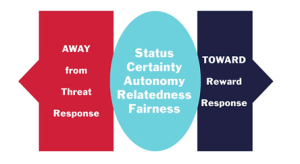Leaders,
Aristotle taught us that „without friends no one would choose to live, though he had all other goods.“
Yet, astonishingly enough, it has become so much harder to make genuine human connections and establish trust – crucial prerequisites for successful change. Let me give you an example: My little niece finally started school last Fall. She had been excited about it all summer; kindergarten had become boring, and she felt a strong craving for something new that would give her a chance to learn and be like her big sister. Her first test was fantastic. She is a smart, bright, and creative girl who is able to articulate herself very clearly. She does know what she wants. To our big surprise – her second test was a disaster. Her parents needed to sign a notification that had to be returned to her teacher. Yikes.
When I asked her “What was going on?”, she answered “I disagree with my teacher’s leadership style. She does not keep her promises; this is misbehavior.” “Well, I can relate to that, kiddo. But what is the reason for this bad test result?” “I just wanted to punish my teacher … . I don’t like unfairness.”, my niece answered. “Your dislike of unfairness is quite understandable, sweetheart.” I still didn’t quite get why she had chosen this counterproductive measure, so I continued “How did it make you feel?” “Very sad. Can we talk about something else now, Annette?“
I have been thinking about our conversation for quite a while. What really strikes me is her beautiful sense of justice, and her revolutionary spirit; and of course, the fact that similar situations can be found in the corporate world. Who always walks the talk? Or who consistently displays a level of integrity that would blow their mothers or elementary school teachers away?
Neuroscience revealed and confirmed that our brains are deeply social, and there is a built-in negativity bias in our systems. Threatening, negative stimuli are processed nine times more strongly by our nervous system than positive stimuli. The brain does not differentiate whether the threat is real or imagined in our thoughts; the result is the same. When people are in a threat state, like my niece was, the amygdala releases the stress hormone cortisol into the blood flow. Then people go into flight or freeze mode, i.e. they abandon and run away from the situation; or they are blocked and hindered to take further action.
When people are in threat mode, their prefrontal cortex – the executive brain – shuts down, their ability to process information and make decisions decreases, they experience uncertainty or tunnel-vision and are focused on data and problems. Consequently, they produce substantially fewer insights.
In organizations the threat state of their brains leads to unproductivity and conflict situations. But how can leaders countervail this effect? By taking actions that trigger the brain’s reward system. When people are in reward state, the reward circuit of the brain is activated and the hormone dopamine is released, leading to positive sensations and emotions like curiosity, joy, pleasure, and happiness. People in reward mode are engaged and focused on solutions and connections. Organizations and their leaders can reduce threat by applying five relevant levers as described by David Rock.
- Status – Relative importance to others
- Certainty – Being able to predict the future
- Autonomy – A feeling of control over events impacts stress levels
- Relatedness – A sense of safety with others, of friend rather than foe
- Fairness – Perception of fair exchanges between people
Social connection is a need as basic as oxygen, water or food. The pain of social separation or rejection may not be very different from physical pain. Actually, the anticipation and experience of being socially excluded has been shown to have damaging psychological, behavioral, and physiological effects. The knowledge and awareness of the similarity between physical and social pain provides us with the opportunity to proceed by applying heightened mindfulness and in alignment with the insight that the SCARF® model offers.
„When will we make the same breakthroughs in the way we relate to each other, as we have made in technology?“ Theodore Zeldin, Philosopher (*1933)
My niece not only is brave and adventurous but also likes to talk with others and engage them in a good conversation. She recuperated fast and her enthusiasm for school was back. So she approached her teacher after class a couple of days later to share with her what she had observed, how that had made her feel and how she interpreted it (yes, we had practiced some non-violent communication techniques prior …. ). Needless to say that her teacher was impressed, even grateful and apologized to her. Their relationship certainly was strengthened. Healthy work relationships make all the difference. When people’s „SCARF®“ is well respected, they are able to perform at their best.
Collaborating with Inspired Executives helps you develop a mindset for growth, minimize threat in your area of responsibility and with your teams and facilitate and communicate learning in your organization. Contact us! As an appetizer for you to get an idea of what change or breaking habits is and means, we offer our free eBook „Energetic? Change! Exceptional Leaders use Leadership Energy.“ to you. Just download it! Please share with us your stories of your favorite approach to successful transformations below.
Greetings from Frankfurt, Annette and the Inspired Executives Team.

